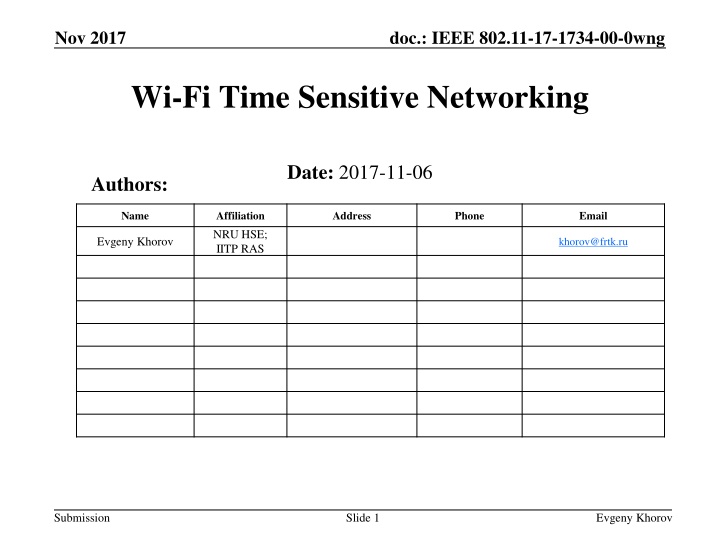
Time-Sensitive Networking in Wi-Fi: Meeting Low Latency Requirements
Explore the discussion on meeting low latency requirements with IEEE 802.11 for Wi-Fi in 5G technology applications like gaming, robotics, and V2X communication. Discover how IEEE 802.1 standards enhance time-sensitive networking capabilities for efficient data transmission and reduced packet delay.
Download Presentation

Please find below an Image/Link to download the presentation.
The content on the website is provided AS IS for your information and personal use only. It may not be sold, licensed, or shared on other websites without obtaining consent from the author. If you encounter any issues during the download, it is possible that the publisher has removed the file from their server.
You are allowed to download the files provided on this website for personal or commercial use, subject to the condition that they are used lawfully. All files are the property of their respective owners.
The content on the website is provided AS IS for your information and personal use only. It may not be sold, licensed, or shared on other websites without obtaining consent from the author.
E N D
Presentation Transcript
Nov 2017 doc.: IEEE 802.11-17-1734-00-0wng Wi-Fi Time Sensitive Networking Date: 2017-11-06 Authors: Name Affiliation NRU HSE; IITP RAS Address Phone Email Evgeny Khorov khorov@frtk.ru Submission Slide 1 Evgeny Khorov
Nov 2017 doc.: IEEE 802.11-17-1734-00-0wng Motivation On Tutorial session, Wi-Fi as a 5G technology was discussed 5G requirements include not only throughput, but also delay For low latency communications, delay should not exceed 1ms Applications Gaming Wireless Remote Control Robotics V2X The aim of this presentation is to discuss how we can meet delay requirements with 802.11 Submission Slide 2 Evgeny Khorov
Nov 2017 doc.: IEEE 802.11-17-1734-00-0wng IEEE 802.1 Activities Published Standards for Time-Sensitive Networking: IEEE Std 802.1Qbu-2016 - IEEE Standard for Local and Metropolitan Area Networks -- Bridges and Bridged Networks -- Amendment 26: Frame Preemption. It allows a Bridge Port to suspend the transmission of non time critical frames while one or more time critical frames are transmitted. IEEE Std 802.1Qbv-2015 - IEEE Standard for Local and Metropolitan Area Networks -- Bridges and Bridged Networks -- Amendment 25: Enhancements for Scheduled Traffic. It specifies time aware queue draining to schedule the transmission of frames relative to a known time scale. IEEE Std 802.1Qca-2015 - IEEE Standard for Local and Metropolitan Area Networks -- Bridges and Bridged Networks -- Amendment 24: Path Control and Reservation. It extends the application of Intermediate System to Intermediate System (IS-IS) to bridged networks in order to provide explicit trees for data traffic. They are being rolled into 802.1Q by the ongoing P802.1Q-REV project. Submission Slide 3 Evgeny Khorov
Nov 2017 doc.: IEEE 802.11-17-1734-00-0wng What makes Wi-Fi not Time Sensitive Packet Delay = Queueing Delay + Packet Transmission Time A TSN packet shall wait while at least the head-of-line packet is being transmitted Packet Transmission Time includes channel access time and PPDU duration (plus retries, if any) Maximal PPDU duration in 11ax exceeds 5 ms Because of unlicensed spectrum, the channel may be busy with transmission of other devices Submission Slide 4 Evgeny Khorov
Nov 2017 doc.: IEEE 802.11-17-1734-00-0wng Reducing Queueing Delay Main idea: Stop transmitting a non-TSN frame when a TSN frame arrives. This is similar to IEEE Std 802.1Qbu-2016 A STA can easily stop its own frame, but how to stop other frame transmissions Submission Slide 5 Evgeny Khorov
Nov 2017 doc.: IEEE 802.11-17-1734-00-0wng Reducing Packet Transmission Time Main idea: reduce channel access time using another radio, adaptively choose robust MCS and protect transmission from collisions Submission Slide 6 Evgeny Khorov
Nov 2017 doc.: IEEE 802.11-17-1734-00-0wng Reducing Channel Access Time Main idea: use dual radio, similarly to WUR (802.11ba) The main radio is used for usual transmission. The auxiliary radio is used to ask neighboring STAs to stop ongoing non-TSN transmissions. Radios operate in different bands The auxiliary radio cannot be used for data transmission. It can be combined with WUR or extend WUR idea. It can be also used to wake-up the intended receiver from microsleep or doze state. Submission Slide 7 Evgeny Khorov
Nov 2017 doc.: IEEE 802.11-17-1734-00-0wng Simple Example of WTSN Handshake Sent with auxiliary radio TSN Frame arrives in the queue Backoff TSN Frame TSN AIFS Notification STA1 Ongoing Transmission Cancelled Transmission STA2 ACK AP STA2 Receives TSN Notification and stops its transmission Submission Slide 8 Evgeny Khorov
Nov 2017 doc.: IEEE 802.11-17-1734-00-0wng Open Issues Shall the transmission of the non-TSN frame be considered as unsuccessful transmission attempt? How to save partially transmitted data? How can the receiver of the TSN frame microsleep during non-TSN transmissions for other STAs? Submission Slide 9 Evgeny Khorov
Nov 2017 doc.: IEEE 802.11-17-1734-00-0wng Straw Poll Is the problem of Time Sensitive Networking with 802.11 interesting to you? Yes No Abstain Submission Slide 10 Evgeny Khorov
